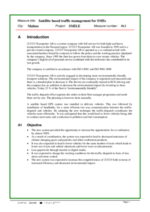Satellite-based traffic management
Thematic areas
Urban logistics
Summary
Using satellite and mobile phone technology, a more efficient goods distribution system was developed for small and medium-sized enterprises, eliminating unnecessary trips and cutting fuel consumption.Photo credit: 215 215
Implementing sustainable mobility
The private courier company 215215 Transporter AB has a fleet of over 20 vehicles, although prior to measure implementation it had no system for capturing real-time positioning data. Communication between the operator and vehicle drivers regarding the distribution of tasks was based on mobile phones, with calls being made by the operator to those drivers expected to be the most relevant to an incoming task.
In order to optimise goods distribution, transport planning and vehicle loading, it was decided to install GPS equipment in every vehicle in the fleet, along with handheld devices for more efficient communication between the dispatch centre and the vehicles. The aim was for fewer vehicles to carry out more tasks, thus reducing fuel consumption and pollution.
The measure was implemented as part of 215215 Transporter AB’s active efforts to develop more environmentally friendly transport solutions. The new equipment was also designed to create a report on the environmental benefits of freight coordination for each of the company’s customers.
Specifically, the measure aimed to ensure increased efficiency and lower environmental impact via:
- better coordination;
- a reduction in emissions of greenhouse gases, particulates and other pollutants;
- the use of fewer vehicles for the same number of tasks, leading to lower wear on vehicles and infrastructure;
- less paperwork through the development of digital media; and
- a greater degree of control at the dispatch centre.
Progress
The GPS equipment was installed in 20 vehicles in November 2005, allowing the control centre to receive updated information about vehicle positions twice a minute. This made it possible for the company to deal efficiently with rapid, unplanned goods distribution in the city.
Outcomes
The measure was a great success: average driven distances were lowered and coordination improved dramatically.
Evaluation was based on four selected vehicles out of the fleet. On average, the total number of tasks per day for all four drivers was 40.3 in 2004 and 41.5 in 2005, a small increase of around 3 percent. This means that fewer vehicles were needed and fewer kilometres covered for the same number of tasks, thus reducing pollution and fuel consumption.










